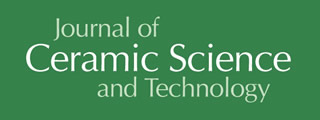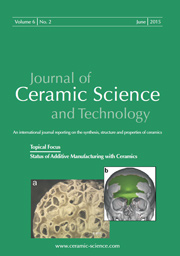Articles
All articles | Recent articles
Study on the Effect of MgO Addition on the Physical, Mechanical and Thermal Properties of Alumina-Zirconia-Carbon Refractories
M. Abolfazli, M. Hossein Paydar
Department of Materials Science and Engineering, School of Engineering, Shiraz University, Shiraz, Iran
received May 31, 2021, received in revised form October 12, 2021, accepted October 13, 2021
Vol. 13, No. 1, Pages 9-14 DOI: 10.4416/JCST2021-00009
Abstract
In this study, the effect of magnesium oxide addition (0 – 10 wt%) on the microstructure, mechanical properties, corrosion and oxidation resistance of alumina-graphite refractory bodies containing 20 wt% zirconia was investigated. Samples were fabricated by mixing raw materials with phenolic resin as a binder. The powder mixtures were isostatically pressed at 850 bar and sintered at 1 400 °C for 8 h under reducing atmosphere. The results showed that the presence of MgO reduces the bulk density, which causes more slag penetration and thus reduces corrosion resistance. Also, evaluation of the mechanical properties reveals that with increasing magnesium content, the flexural strength and compressive strength of the samples decrease. Furthermore, it has been proved that positive permanent linear change owing to spinel formation leads to a reduction in thermal shock resistance.
![]() Download Full Article (PDF)
Download Full Article (PDF)
Keywords
Alumina-carbon composite, refractory, stopper, microstructure, mechanical properties, magnesia
References
1 Bakr, I.M., Wahsh, M.M.S.: Fabrication and characterization of multi-phase ceramic composites based on zircon-alumina-magnesia mixtures, Mat. & Des., 35, 99 – 105, (2012).
2 Garbers-Craig, A.M.: Presidential address: how cool are refractory materials?, J. S. Afr. Inst. Min. Metall., 108, [9], 491 – 506, (2008).
3 Ruffaldi A.: State of the art and recent development of carbon bonded refractory materials. Paper presented at: TICR 2004., Proceedings of the Tehran International Conference on Refractories, Tehran-Iran, 2004.
4 Khanna, R., Sahajwalla, V., Rodgers, B., McCarthy, F.: Dissolution of carbon from alumina-carbon mixtures into liquid iron: influence of carbonaceous materials, Metall. & Mat. Trans. B, 37, [4], 623 – 632, (2006).
5 Rashmi R.R.: Studies on the effect of alumina aggregates on the performances of alumina-carbon refractories. M.Sc. Thesis. Department of ceramic engineering national institute of technology. Rourkela-76008, 2009.
6 Zhu, T., Li, Y., Sang, S.: Heightening mechanical properties and thermal shock resistance of low-carbon magnesia-graphite refractories through the catalytic formation of nanocarbons and ceramic bonding phases, J. Alloy. Compd., 783, 990 – 1000, (2019).
7 Yagovtsev, A.V., Obabkov, N.V., Kashcheev, I.D.: Study of effect of zirconia-graphite material composition on its properties, Refract. Ind. Ceram., 54, [5], 388 – 391, (2014).
8 Liu, Q.C., Zheng, H.M., Lu, C.F., Gao, W.: Corrosion resistance of high-alumina graphite based refractories to the smelting reduction melts, J. Mater. Sci. & Eng., 2, [12], 49 – 53, (2008).
9 Resende, W.S., Stoll, R.M., Justus, S.M., Andrade, R.M., Lono, E., Baldo, J.B., Leite, E.R., Paskocimas, C.A., Soledade, L.E.B., Gomes, J.E., Varela, J.A.: Key feature of alumina/magnesia/graphite refractories for steel ladle lining, J. Eur. Ceram. Soc., 20, 1419 – 1427, (2000).
10 Khoshkalam, M., Faghihi-Sani, M.A.: An investigation on mechanical properties of alumina-zirconia-magnesia spinel composite ceramics fabricated by gel-casting using solution combustion synthesized powder, Mater. Sci. & Eng. A., 587, 336 – 343, (2013).
11 Rand, B., Ahmed, A.S., Ramos, V.P.S.: The role of carbon in refractories, Iran. J. Mat. Sci. & Eng., 1, [3], 9 – 15, (2004).
12 Klewski, M., Lucyna, O., Michał, S.: Alumina-magnesia-carbon bricks for steel ladle. In: Proceedings of the Unified International Technical Conference on Refractories (UNITECR 2013). Hoboken, NJ, USA, 2014.
13 Mukhopadhyay, S., Chattopadhyay, A.K., Das, G.C., Maitra, S.: Effect of MgO grain size on thermal expansion behavior of alumina-magnesia-carbon refractory, Int. J. of Appl. Ceram. Tech., 11, [6], 1012 – 1019, (2014).
14 Babakhanova, Z.A., Aripova, M.K.: Highly refractory alumina-periclase-carbon ceramic materials based on a spinel binder, Refract. Ind. Ceram., 59, [5], 454 – 458, (2019).
15 Li, J.M., Hu, Y.B.: O2 atmospheric annealing-tunable defects in ionic oxide MgO nanoribbons, Appl. Phys. Lett., 114, [20], 203101, (2019).
16 Budnikov, P.P.: The technology of ceramics and refractories. M.I.T. Press, Cambridge, 1964.
17 Kiani, M., Ebadzadeh, T.: Effect of mechanical activation and microwave sintering on crystallization and mechanical strength of cordierite nanograins, Ceram. Int., 41, 2342 – 2347, (2015).
18 Benito, J.M., Turrillas, X., Cuello, G.J., De Aza, A.H., De Aza, S., Rodríguez, M.A.: Cordierite synthesis. A time-resolved neutron diffraction study, J. Eur. Ceram. Soc., 32, 371 – 379, (2012).
19 Li, Y., Cheng, X., Zhang, R., Wang, Y., Zhang, H.: Effect of excess MgO on the properties of cordierite ceramic sintered by solid-state method, Int. J. Appl. Ceram. Tech., 12, 443 – 450, (2015).
Copyright
Göller Verlag GmbH


